Efficacy of Weed Management Techniques on Weed Control, Biomass Yield, and Soil Herbicide Residue in Transplanted Wild Marigold (Tagetes minuta L.) under High Rainfall Conditions of Western Himalaya
Abstract
:1. Introduction
2. Material and Methods
2.1. Site Description
2.2. Treatments and Field Procedures
2.3. Data Collection
2.4. Herbicide Soil Residue
2.4.1. Sample Preparation Procedure
2.4.2. LC-MS/MS Analysis and Validation
- Column: Zorbax Eclipse Plus C-18 (Agilent Technologies, Santa Clara, CA, USA).
- Column dimensions: 3 mm i.d., 10 cm length, and 3.5 μm column thickness.
- Detector: triple quadrupole mass detector.
- Mobile phase: Solvent A (80:20, 5 mM ammonium format solution in water: methanol) and Solvent B (10:90, 5 mM ammonium format solution in water: methanol). Solvent A and B were mixed and maintained in a 1:1 ratio during the total run.
- Run time: 6 min.
- Flow rate: 0.2 mL min−1.
- Injection volume: 1 μL.
- Heat block and desolvation line temperatures: 400 °C and 250 °C, respectively.
- Drying and nebulizing gas: nitrogen (flow rates: 15 L min−1 and 3 L min−1, respectively).
- CID gas: ultrapure argon.
2.5. Statistical Method
3. Results
3.1. Weed Flora
3.2. Weed Density (Number of Weeds)
3.3. Weed Dry Biomass
3.4. Weed Control Efficiency (WCE) and Weed Index (WI)
3.5. Crop Yield
3.6. Crop–Weed Interaction
3.6.1. Correlation Analysis
3.6.2. Principal Component Analysis (PCA)
3.7. Herbicide Residue
4. Discussion
4.1. Weed Density and Biomass
4.2. Crop Yield
4.3. Herbicide Residue
5. Conclusions
Author Contributions
Funding
Institutional Review Board Statement
Informed Consent Statement
Data Availability Statement
Acknowledgments
Conflicts of Interest
References
- Holm, L.J.; Doll, E.; Holm, J.P.; Herberger, J. World Weeds, Natural Histories and Distribution; John Wiley and Sons Inc.: New York, NY, USA, 1997; p. 1129. [Google Scholar]
- Soule, J.A. Infrageneric systematics of Tagetes. In Compositae: Systematics; Hind, D.J.N., Beentje, H.J., Eds.; Royal Botanical Garden: Kew, UK, 1996; pp. 435–443. [Google Scholar]
- Singh, V.; Singh, B.; Kaul, V.K. Domestication of wild marigold (Tagetes minuta L.) as a potential economic crop in western Himalaya and north Indian plains. Econ. Bot. 2003, 57, 535–544. [Google Scholar] [CrossRef]
- Wang, C.; Chen, C. Tagetes minuta L. (Asteraceae), a newly naturalized plant in Taiwan. Taiwania 2006, 51, 32–35. [Google Scholar]
- Gakuubi, M.M.; Wanzala, W.; Wagacha, J.M.; Dossaji, S.F. Bioactive properties of Tagetes minuta L. (Asteraceae) essential oils: A review. Am. J. Essent. Oils Nat. Prod. 2016, 4, 27–36. [Google Scholar]
- Sadia, S.; Khalid, S.; Qureshi, R.; Bajwa, A. Tagetes minuta L. a useful underutilized plant of family Asteraceae: A review. Pak. J. Weed Sci. Res. 2013, 19, 179–189. [Google Scholar]
- Walia, S.; Mukhia, S.; Bhatt, V.; Kumar, R.; Kumar, R. Variability in chemical composition and antimicrobial activity of Tagetes minuta L. essential oil collected from different locations of Himalaya. Indian Crops Prod. 2020, 150, 112449. [Google Scholar] [CrossRef]
- Rathore, S.; Walia, S.; Kumar, R. Biomass and essential oil of Tagetes minuta influenced by pinching and harvesting stage under high precipitation conditions in the western Himalayas. J. Essent. Oil Res. 2018, 30, 360–368. [Google Scholar] [CrossRef]
- Cornelius, W.W.; Wycliffe, W. Tagetes (Tagetes minuta) Oils. In Essential Oils in Food Preservation, Flavor and Safety; Preedy, V.R., Ed.; Academic Press: Cambridge, MA, USA, 2016; pp. 791–802. [Google Scholar]
- Gharde, Y.; Singh, P.K.; Dubey, R.P.; Gupta, P.K. Assessment of yield and economic losses in agriculture due to weeds in India. Crop Prot. 2018, 107, 12–18. [Google Scholar] [CrossRef]
- Mishra, J.S.; Rao, A.N.; Singh, V.P.; Kumar, R. Weed management in major field crops. In Advances in Weed Management; Indian Society of Agronomy: New Delhi, India, 2016; pp. 1–22. [Google Scholar]
- Walia, S.; Kumar, R. Wild marigold (Tagetes minuta L.) an important industrial aromatic crop: Liquid gold from the Himalaya. J. Essent. Oil Res. 2020, 32, 373–393. [Google Scholar] [CrossRef]
- Yousefi, A.R.; Rahimi, M.R. Integration of soil-applied herbicides at the reduced rates with physical control for weed management in fennel (Foeniculum vulgare Mill.). Crop Prot. 2014, 63, 107–113. [Google Scholar] [CrossRef]
- Jabran, K.; Farooq, M.; Hussain, M.; Ehsanullah; Khan, M.B.; Shahid, M.; Lee, D.J. Efficient weeds control with penoxsulam application ensures higher productivity and economic returns of direct seeded rice. Int. J. Agric. Biol. 2012, 14, 901–907. [Google Scholar]
- Kumar, R.; Malik, Y.P.; Punia, S.S. Weed control in fenugreek with pendimethalin and imazethapyr. Indian J. Weed Sci. 2016, 48, 225–227. [Google Scholar] [CrossRef]
- Demer, K.J. Screening of Herbicides for Selective Weed Control in African Marigold (Tagetes erecta). Master’s Thesis, Iowa State University, Ames, IA, USA, 2015. [Google Scholar]
- Santos, J.B.; dos Ferreira, E.A.; da Silva, F.M.; dos Santos, E.A.; Ferreira, L.R. Evaluation of carfentrazone-ethyl as a desiccant for the bean (Phaseolus vulgaris L.) seeds. Revistaceres 2005, 52, 831–842. [Google Scholar]
- Sondhia, S.; Khankhane, P.J.; Singh, P.K.; Sharma, A.R. Determination of imazethapyr residues in soil and grains after its application to soybeans. J. Pest Sci. 2015, 40, 106–110. [Google Scholar] [CrossRef] [Green Version]
- Anonymous. Crop Weather Outlook. All India Coordinated Research Project on Agrometeorology (AICRPAM). Available online: http://www.cropweatheroutlook.in/ (accessed on 14 December 2019).
- Bangi, S.S.; Lal, E.P.; Bangi, S.S.; Sattigeri, U.T. Effect of herbicides on weed control efficiency (WCE) and yield attributes in brinjal (Solanum melongena L.). J. Agric. Vet. Sci. 2014, 7, 59–65. [Google Scholar] [CrossRef]
- Banerjee, T.; Gupta, S.; Singh, B.; Narayanan, N. LC-MS/MS method optimization and validation for trace-level analysis of 71 crop protection chemicals in pulses. Environ. Monit. Assess. 2019, 191, 670. [Google Scholar] [CrossRef]
- Hammer, O.; Harper, D.A.T.; Ryan, P.D. PAST: Paleontological statistics software package for education and data analysis. Palaeontol. Electron. 2001, 4, 1–9. [Google Scholar]
- Imoloame, E.O. Economic evaluation of methods of weed control in soybeans (Glycine Max (L.) Meril) production in the southern Guinea savanna of Nigeria. Niger. J. Exp. Appl. Biol. 2014, 14, 81–85. [Google Scholar]
- Imoloame, E.O. Evaluation of herbicide mixtures and manual weed control method in maize (Zea mays L.) production in the Southern Guinea agro-ecology of Nigeria. Cogent Food Agric. 2017, 3, 1375378. [Google Scholar] [CrossRef]
- Peer, F.A.; Badrul Lone, B.A.; Qayoom, S.; Ahmed, L.; Khanday, B.A.; Singh, P. Effect of weed control methods on yield and yield attributes of Soyabean. Afr. J. Agric. Res. 2013, 8, 6135–6141. [Google Scholar]
- Veeramani, A.; Palchamy, A.; Ramasamy, S.; Rangaraju, G. Integrated weed management in Soybean (Glycine max (L.) Merril) under various plant densities. Madras Agric. J. 2001, 88, 451–456. [Google Scholar]
- Marchioretto, L.D.; Magro, T.D. Weed control and crop selectivity of post-emergence herbicides in common beans. Cienc. Rural 2017, 47, e20160295. [Google Scholar] [CrossRef] [Green Version]
- Rajeswara Rao, B.R.; Rajput, D.K. Organic farming: Medicinal and aromatic plants. In National Seminar on Organic Farming: Current Scenario and Future Thrust at A.N.G.; Royal Agricultural University: Hyderabad, India, 2005; Volume 1. [Google Scholar]
- Singh, A.; Singh, M.; Singh, S. Effective utilization of distillation waste as organic mulch for weed management in the aromatic grass, Citronella java. Int. J. Pest Manag. 2001, 47, 253–257. [Google Scholar] [CrossRef]
- Wehtje, G.; Mosjidis, J.A. Weed Control in Sericea Lespedeza with Imazethapyr. Weed Technol. 2005, 19, 749–752. [Google Scholar] [CrossRef]
- Ram, H.; Singh, G. Studies on the bio-efficacy of herbicides for weed control in soybean (Glycine max L. Merrill) under different sowing methods. Ind. J. Ecol. 2011, 38, 11–13. [Google Scholar]
- Poienaru, S.; Sarpe, N. The residual effect of imazethapyr applied in soybean to barley and winter wheat in Romania. Commun Agric. Appl. Biol. Sci. 2006, 71, 829–835. [Google Scholar]
- Marsh, B.H.; Lloyd, R.W. Soil pH effect on imazaquin persistence in soil. Weed Technol. 1996, 10, 337–340. [Google Scholar] [CrossRef]
- Saha, A.; Bhaduri, D.; Pipariya, A.; Jain, N.K.; Basak, B.B. Behaviour of pendimethalin and oxyfluorfen in peanut field soil: Effects on soil biological and biochemical activities. Chem. Ecol. 2015, 31, 550–566. [Google Scholar] [CrossRef]
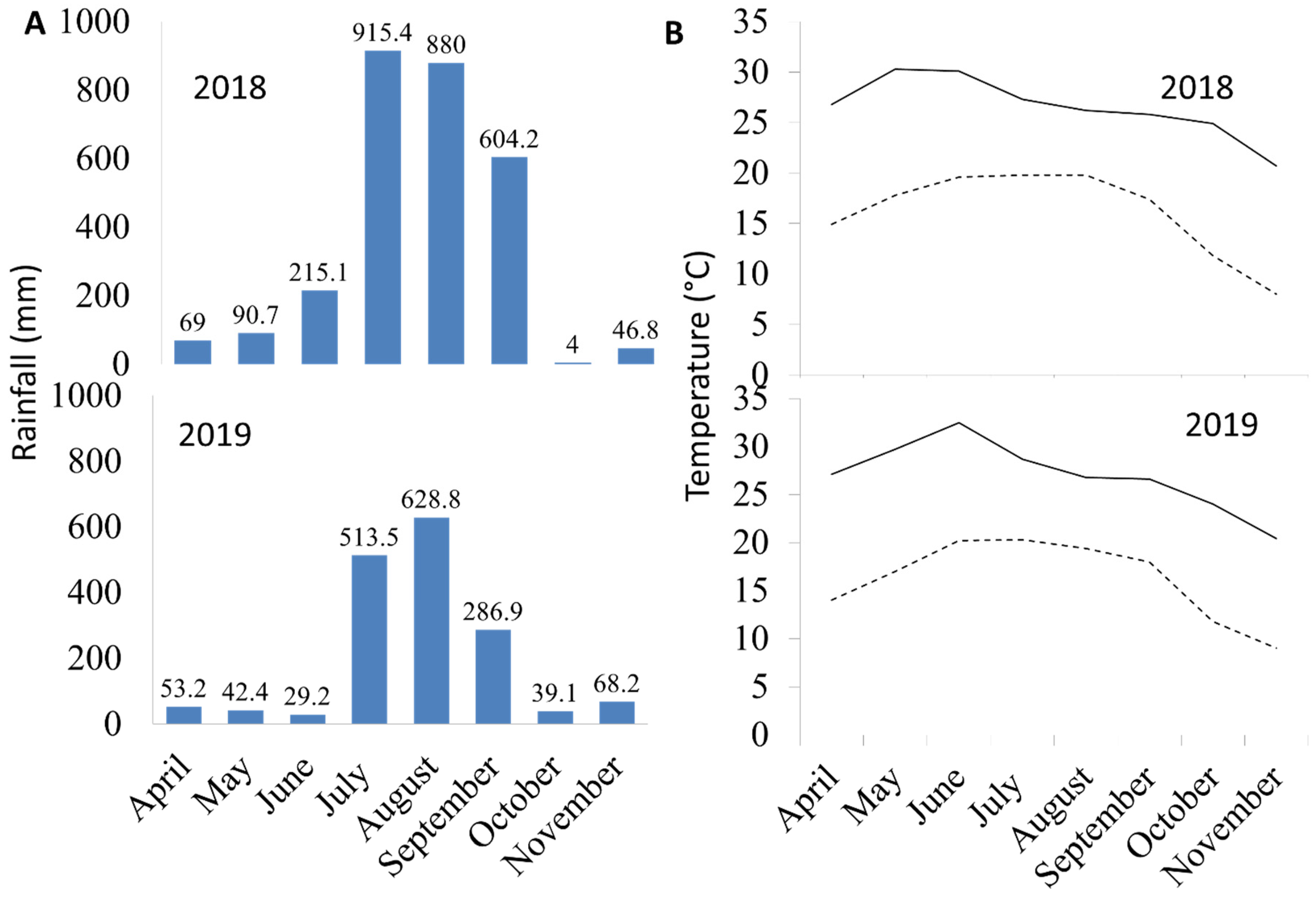
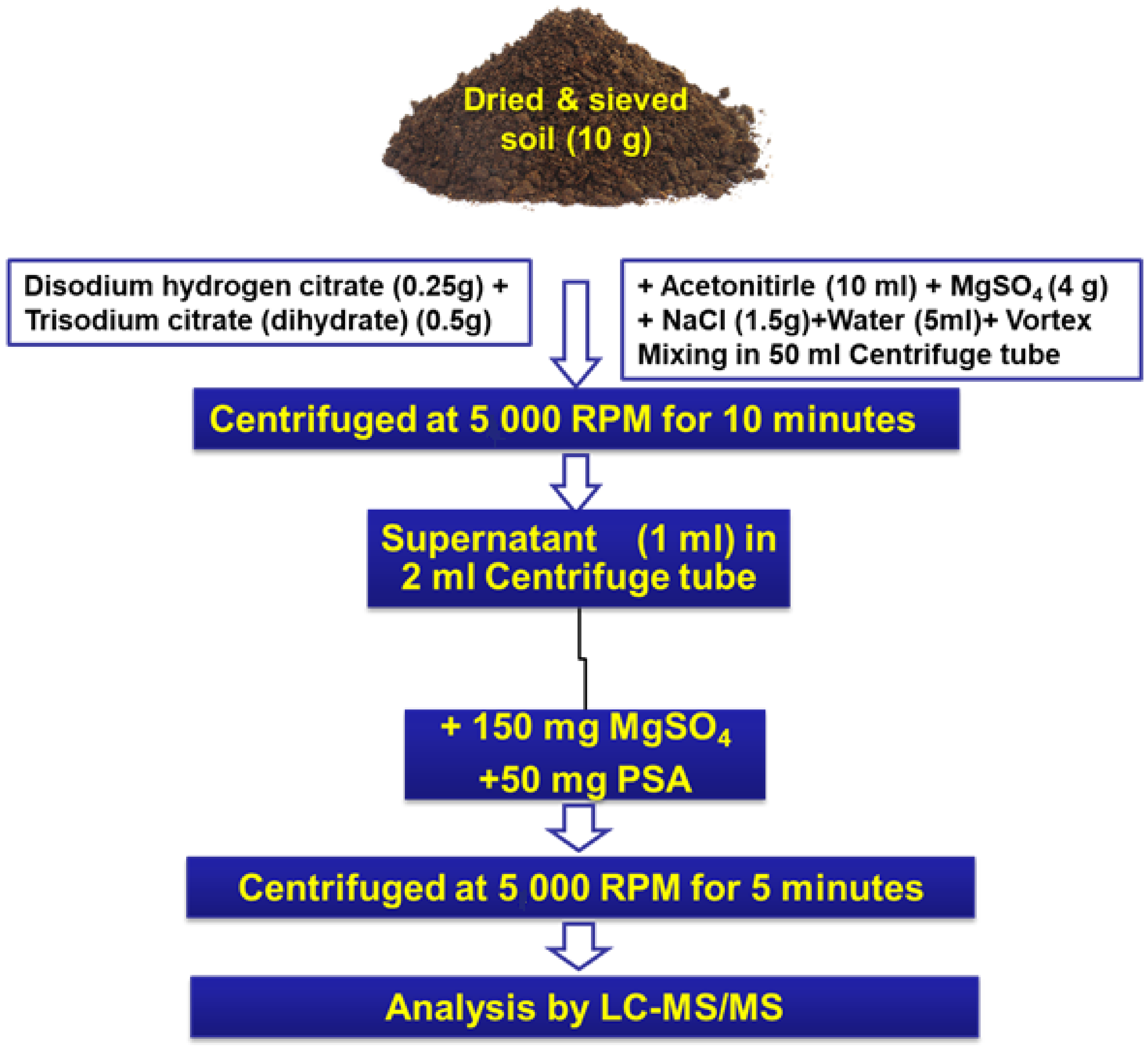
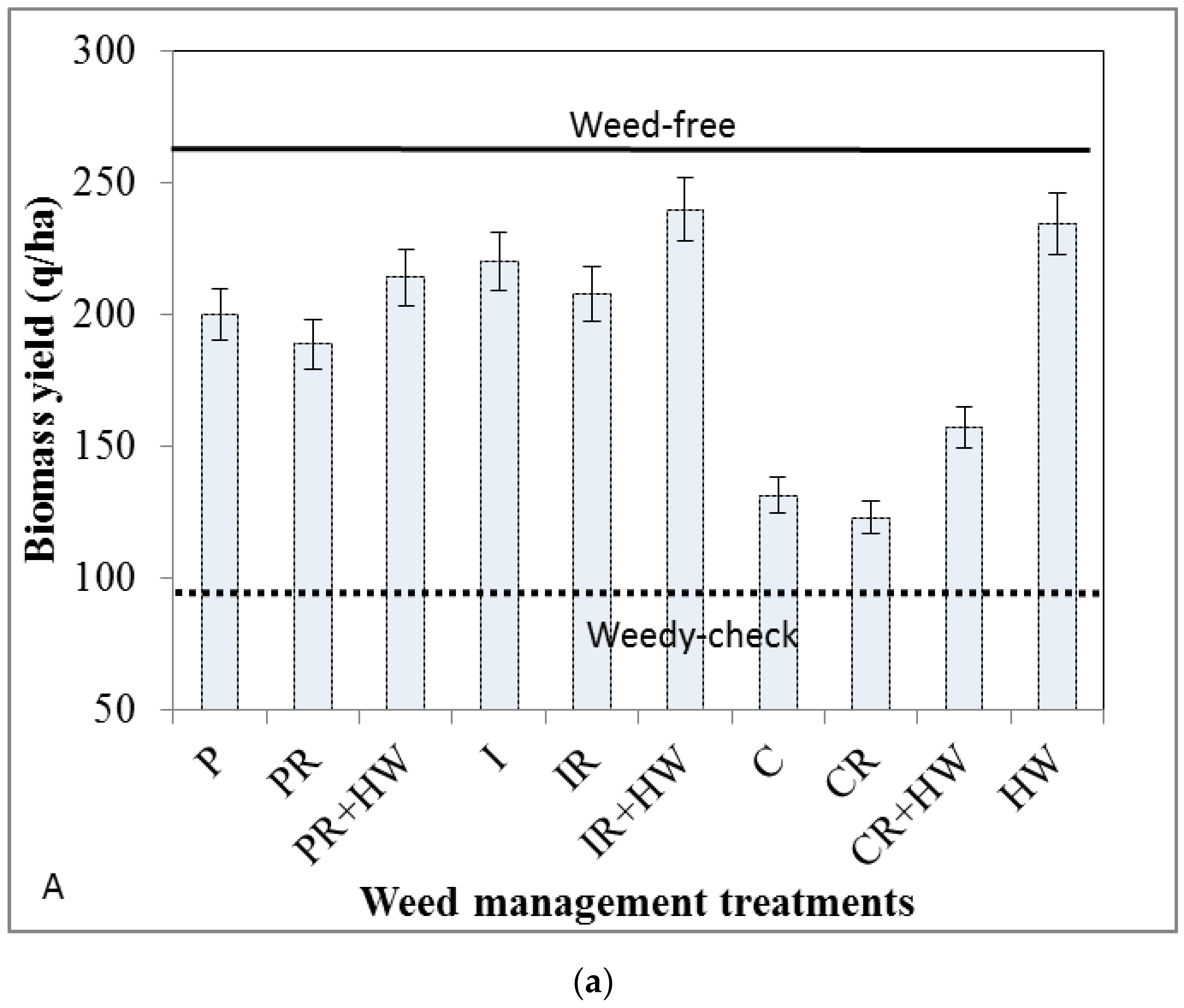


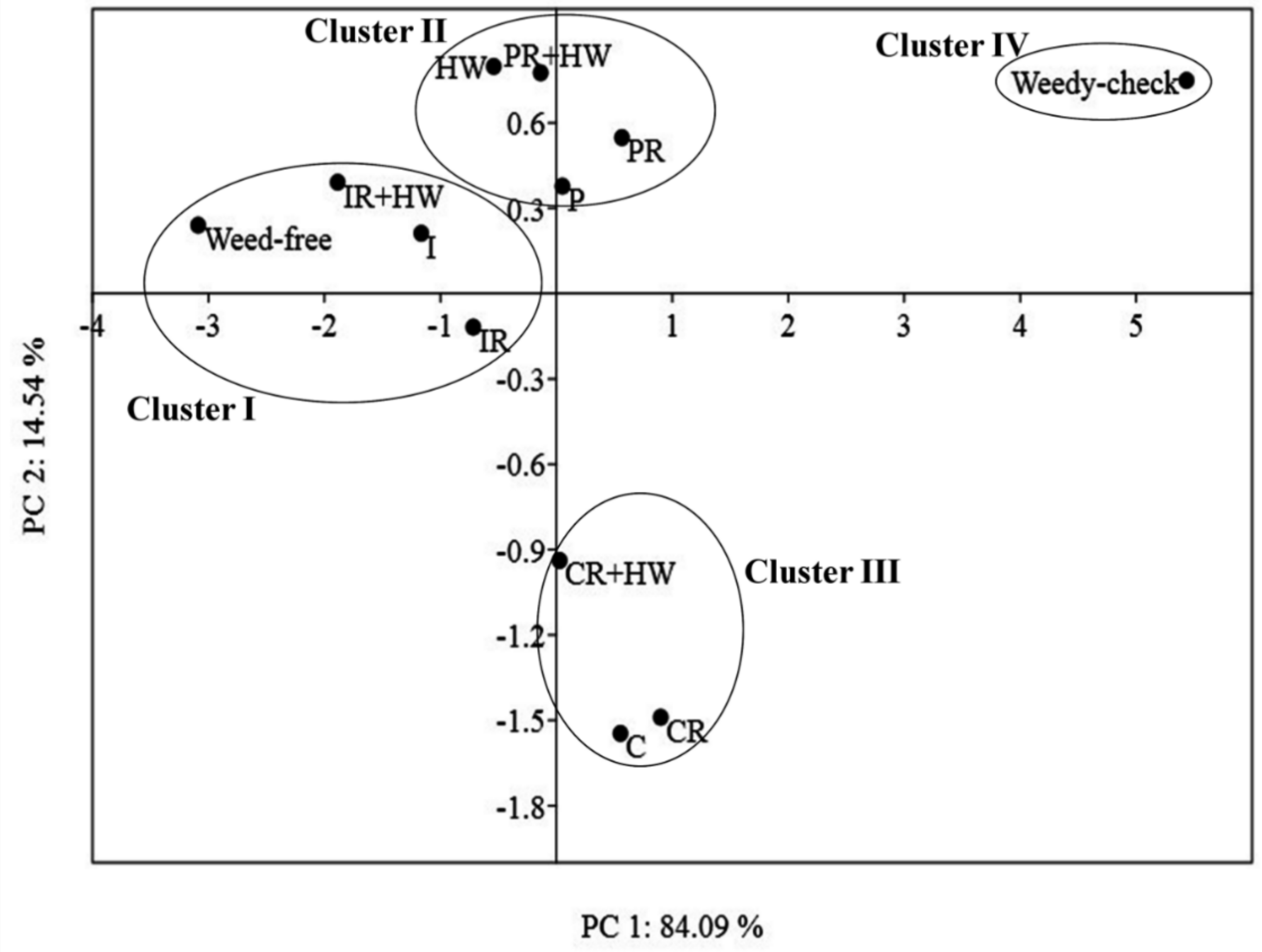
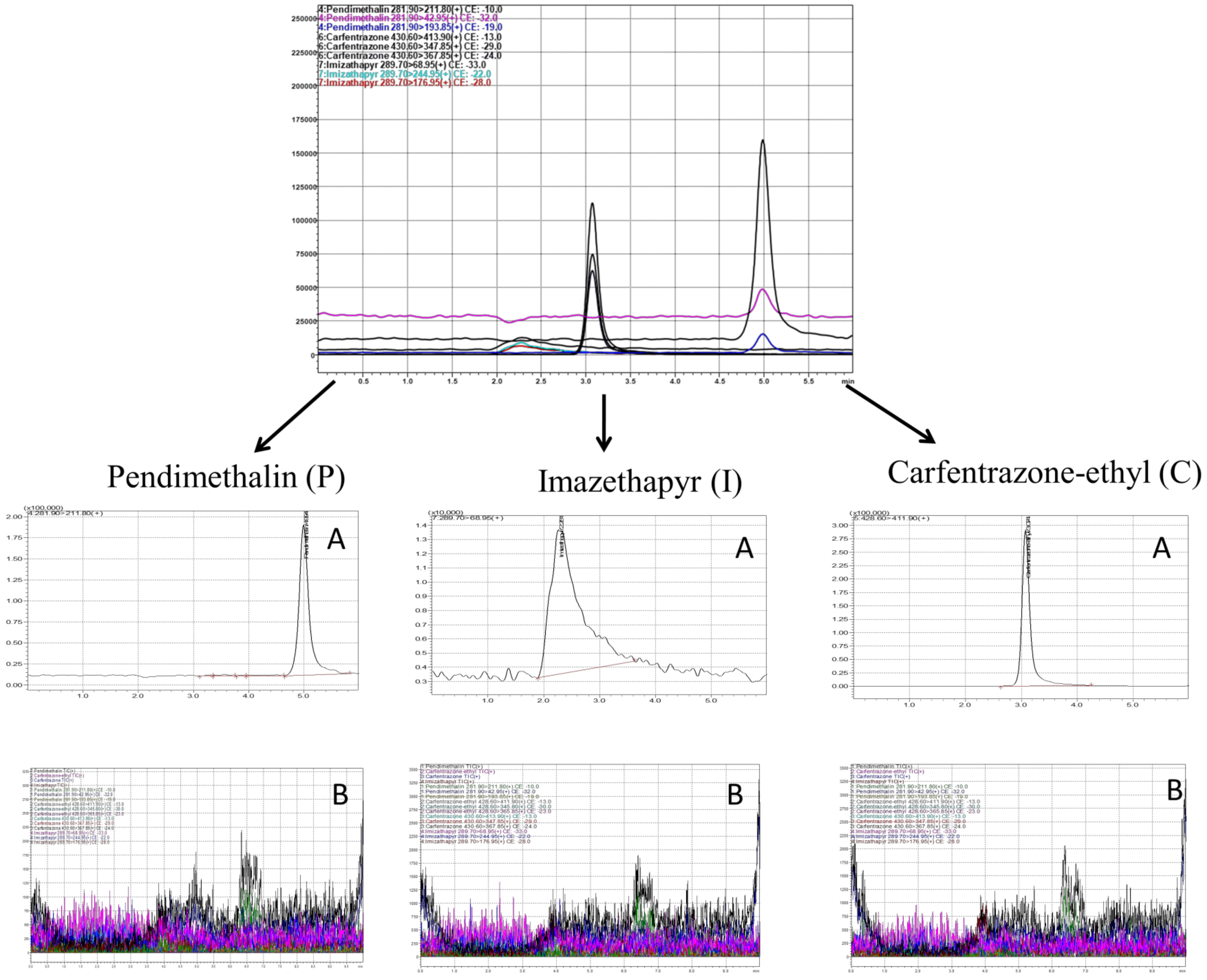
| S.No. | Weed Management Treatments | Abbreviation |
|---|---|---|
| 1 | Recommended dose of Pendimethalin 1.50 kg a.i./ha (pre-emergence) | p |
| 2 | Reduced (R) dose of pendimethalin 1.00 kg a.i./ha (pre-emergence) | PR |
| 3 | Reduced dose of pendimethalin 1.00 kg a.i./ha (pre-emergence) followed by (fb) 1 hand-weeding (HW) at 25 days after transplanting (DAT) | PR+HW |
| 4 | Recommended dose of imazethapyr 0.10 kg a.i./ha (pre-emergence) | I |
| 5 | Reduced dose of imazethapyr 0.05 kg a.i./ha (pre-emergence) | IR |
| 6 | Reduced dose of imazethapyr 0.05 kg a.i./ha (pre-emergence) fb 1 HW at 25 DAT | IR+HW |
| 7 | Recommended dose carfentrazone-ethyl 0.02 kg a.i./ha (post-emergence) at 30 DAT | C |
| 8 | Reduced dose of carfentrazone-ethyl 0.01 kg a.i./ha (post-emergence) at 30 DAT | CR |
| 9 | Reduced dose of carfentrazone-ethyl 0.01 kg a.i./ha (post-emergence) at 30 DAT fb 1 HW at 50 DAT | CR+HW |
| 10 | Hand-weeding (25 and 50 DAT) | HW |
| 11 | Weed-free during the whole season | Weed-free |
| 12 | Weedy infested during the whole season | Weedy-check |
| S.No. | Herbicide | Molecular Ion | Retention Time (min) | CE1 | Quantifier (Q1) | CE2 | Quantifier (Q2) | CE3 | Quantifier (Q3) | Regression Equation | Correlation Coefficient (r) |
|---|---|---|---|---|---|---|---|---|---|---|---|
| 1 | Pendimethalin | 281.90 (M + H)+ | 4.992 | −10 | 281.90 > 211.80 | −32 | 281.90 > 42.95 | −19 | 281.90 > 193.85 | Y = 2.42428e + 006 × −22898.8 | 0.9998 |
| 2 | Imazethapyr | 289.70 (M + H)+ | 2.261 | −33 | 289.70 > 68.95 | −22 | 289.70 > 244.95 | −28 | 289.70 > 176.95 | Y = 414367 × − 33238.8 | 0.9963 |
| 3 | Carfentrazone-ethyl | 430.60 (M + NH4)+ | 3.074 | −13 | 430.60 > 413.90 | −29 | 430.60 > 347.85 | −24 | 430.60 > 367.85 | Y = 3.19132e + 006 × −109164 | 0.9996 |
| Source of Variation | df | Weed Density | Weed Dry Biomass | WCE (%) | WI (%) | Biomass Yield (q ha−1) |
|---|---|---|---|---|---|---|
| Year (Y) | 1 | * | ** | ns | ns | ** |
| Weed management (M) | 11 | ** | ** | ** | ** | ** |
| Y × M | 11 | ns | ns | ns | * | * |
| Error | 46 | |||||
| CV | - | 9.79 | 9.80 | 8.52 | 10.96 | 8.23 |
| Treatment | Weed Density (per m−2) | Weed Dry Biomass (g m−2) | Weed Control Efficiency (%) | Weed Index (%) |
|---|---|---|---|---|
| Year | ||||
| 2018 | 12.84 b | 18.11 b | 79.73 ns | 27.24 ns |
| 2019 | 13.70 a | 19.41 a | 78.49 ns | 28.35 ns |
| Weed management * | ||||
| p | 14.91 ghi | 21.08 i | 79.01 hi | 23.99 fg |
| PR | 17.29 k | 24.45 k | 72.16 k | 26.33 gh |
| PR+HW | 15.40 ij | 21.79 ij | 78.21 hij | 18.09 cde |
| I | 9.64 c | 13.64 c | 91.32 bc | 15.86 cd |
| IR | 10.47 cd | 14.80 cd | 89.85 cd | 23.12 f |
| IR+HW | 7.14 b | 10.10 b | 95.31 b | 8.02 b |
| C | 11.21 cdef | 15.85 cde | 88.38 cdef | 49.16 j |
| CR | 12.76 efg | 18.05 g | 84.95 efg | 51.36 jk |
| CR+HW | 10.97 cde | 15.52 def | 88.98 cde | 38.18 i |
| HW | 13.91 gh | 19.67 gh | 81.94 gh | 14.55 c |
| Weed-free | 1.00 a | 1.00 a | 100.00 a | 0.00 a |
| Weedy-Check | 33.03 l | 46.71 l | 0.00 l | 64.86 l |
| S.No. | Herbicides | Dose | Dose Type | Residue at Harvest |
|---|---|---|---|---|
| 1 | Pendimethalin | 1.50 kg a.i./ha | Recommended | BDL |
| 1.00 kg a.i./ha | Reduced | BDL | ||
| 2 | Imazethapyr | 0.10 kg a.i./ha | Recommended | BDL |
| 0.05 kg a.i./ha | Reduced | BDL | ||
| 3 | Carfentrazone-ethyl | 0.02 kg a.i./ha | Recommended | BDL |
| 0.01 kg a.i./ha | Reduced | BDL |
Publisher’s Note: MDPI stays neutral with regard to jurisdictional claims in published maps and institutional affiliations. |
© 2021 by the authors. Licensee MDPI, Basel, Switzerland. This article is an open access article distributed under the terms and conditions of the Creative Commons Attribution (CC BY) license (https://creativecommons.org/licenses/by/4.0/).
Share and Cite
Walia, S.; Banerjee, T.; Kumar, R. Efficacy of Weed Management Techniques on Weed Control, Biomass Yield, and Soil Herbicide Residue in Transplanted Wild Marigold (Tagetes minuta L.) under High Rainfall Conditions of Western Himalaya. Agronomy 2021, 11, 2119. https://doi.org/10.3390/agronomy11112119
Walia S, Banerjee T, Kumar R. Efficacy of Weed Management Techniques on Weed Control, Biomass Yield, and Soil Herbicide Residue in Transplanted Wild Marigold (Tagetes minuta L.) under High Rainfall Conditions of Western Himalaya. Agronomy. 2021; 11(11):2119. https://doi.org/10.3390/agronomy11112119
Chicago/Turabian StyleWalia, Swati, Tirthankar Banerjee, and Rakesh Kumar. 2021. "Efficacy of Weed Management Techniques on Weed Control, Biomass Yield, and Soil Herbicide Residue in Transplanted Wild Marigold (Tagetes minuta L.) under High Rainfall Conditions of Western Himalaya" Agronomy 11, no. 11: 2119. https://doi.org/10.3390/agronomy11112119
APA StyleWalia, S., Banerjee, T., & Kumar, R. (2021). Efficacy of Weed Management Techniques on Weed Control, Biomass Yield, and Soil Herbicide Residue in Transplanted Wild Marigold (Tagetes minuta L.) under High Rainfall Conditions of Western Himalaya. Agronomy, 11(11), 2119. https://doi.org/10.3390/agronomy11112119







